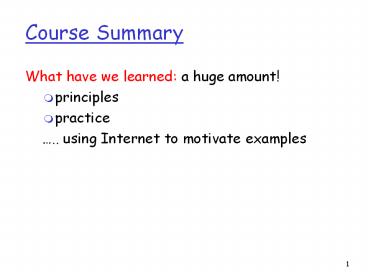Course Summary - PowerPoint PPT Presentation
Title:
Course Summary
Description:
... connection-oriented transport TCP congestion control Chapter 4: Network Layer understand principles behind ... Different types of medium access protocols ... – PowerPoint PPT presentation
Number of Views:178
Avg rating:3.0/5.0
Title: Course Summary
1
Course Summary
- What have we learned a huge amount!
- principles
- practice
- .. using Internet to motivate examples
2
Chapter 1 Introduction
- Our goal
- get feel and terminology
- more depth, detail later in course
- approach
- use Internet as example
- Overview
- whats the Internet
- whats a protocol?
- network edge
- network core
- Internet/ISP structure
- performance loss, delay
- protocol layers, service models
- network modeling
3
Chapter 2 Application Layer
- conceptual, implementation aspects of network
application protocols - transport-layer service models
- client-server paradigm
- peer-to-peer paradigm
- learn about protocols by examining popular
application-level protocols - HTTP
- FTP
- SMTP
- DNS
- web security
- programming network applications
- socket API
4
Chapter 3 Transport Layer
- learn about transport layer protocols in the
Internet - UDP connectionless transport
- TCP connection-oriented transport
- TCP congestion control
- understand principles behind transport layer
services - multiplexing/demultiplexing
- reliable data transfer
- flow control
- congestion control
- reliable multicast
5
Chapter 4 Network Layer
- understand principles behind network layer
services - forwarding
- routing (path selection) performance vs policy
- dealing with scale
- how a router works
- NATs, IPv6
- instantiation in the Internet
- broadcast, multicast routing
6
Chapter 5 The Data Link Layer
- understand principles behind data link layer
services - error detection, correction
- sharing a broadcast channel multiple access
- ALOHA (slotted and unslotted)
- Ethernet
- link layer addressing
- Ethernet switches
- link virtualization, brief introduction to ATM,
virtual circuits
7
Chapter 6 Wireless Mobile Networks
- Wireless
- Wireless links, characteristics
- IEEE 802.11 wireless LANs (wi-fi)
- Cellular Internet Access
- architecture
- standards
- Mobility
- Principles addressing and routing to mobile
users - Mobile IP
- Handling mobility in cellular networks
- Mobility and higher-layer protocols
8
Chapter 8 Network Security
- understand principles of network security
- cryptography and its many uses beyond
confidentiality - authentication
- message integrity
- certificate authority
- security in practice
- firewalls
- security in application, transport, network, link
layers (WEP)
9
Chapter 7Multimedia Networking
- Principles
- making the best of best effort service
- dealing with delay jitter and loss
- mechanism for providing QoS
- e.g., leaky bucket, weighted fair queuing
- Protocols and Architectures
- specific protocols for best-effort
- e.g., RTP/RTCP, SIP
10
Networked Systems
11
Networking Applications
- financial stock trading, portfolio management
- social voice communication, email, chat,
telecommuting - entertainment - games, music, video, surfing
- medical telemedicine
- networked systems indispensable part of not just
global communication infrastructure but our daily
lives
12
Q Whither goest networking?
- A nobody knows!
- General trends
- ubiquity of communications
- IP dialtone, IP like electricity its
everywhere! - network-capable appliances (e.g., IP toaster)
- issues of scale important 100's of millions of
network-connected devices - mobility important
- people move, need to communicate
- multimedia important
- it is how people communicate
13
Q Whither goest networking?
- increasing link rates, but bandwidth not free in
near future - increased "users"
- increased bandwidth requirements of enabled apps
- high bandwidth to home (DSL, cable modems) a
major driver for future - games, VR, education, information, entertainment
- merger of networking and telephony
- broadcast entertainment (TV) and WWW
- security, reliability, management critical
concerns
14
Our Very Last Note Page!
- this course
- specific architectures, protocols
- fundamental issues APIs, reliable data transfer,
flow/congestion control, routing, multiple
access, addressing, security, multimedia
networking - remember you learned it HERE!
15
Final Exam on 12/10/071030 AM to 1200 noon
- Three parts
- Part 0 Name and course number 1 point
- Part 1 - about 26 questions (1 point each) 1
bonus question (1 point) - Part 2 3-4 questions based on the RSVP paper
3 points (extra credit for cs5480) - Closed book, closed notes, you can bring
calculators - Post midterm material (however, expected to know
important midterm concepts especially TCPs loss
recovery, timeout estimation, etc.)
16
Final Exam on 12/10/071030 AM to 1200 noon
- Important Topics
- Chapter 4 BGP, Broadcast/Multicast Routing,
Virtual circuits - Chapter 5 Different types of medium access
protocols, ALOHA, Ethernet protocols
(derivations, numerical examples), Ethernet
switches, MAC addressing - Chapter 6 IEEE 802.11 protocol (understand
CSMA/CA, SIFS/DIFS, RTS/CTS etc.), IP cellular
network mobility (indirect, direct routing,
HA/FA/COA, HLR/VLR, handover), TCP performance
over mobile wireless networks - Chapter 7 Delay jitter, playout delays, loss
concealment, RTP, SIP, WFQ, Token Bucket, delay
guarantees - Chapter 8 Cryptography symmetric key, public
key, hash functions, Authentication Protocols,
Firewalls and Gateways, WEP, IEEE 802.11i - Do not have to prepare the material taught by
Prof. Patwari - cs6480 RSVP paper
17
Final Exam on 12/10/071030 AM to 1200 noon
- Post Midterm book sections
- Chapter 4 4.2, 4.3 (excluding 4.3.2), 4.5.1,
4.5.2, 4.6.1, 4.6.3, 4.7 - Chapter 5 5.1, 5.2 (excluding 5.2.3), 5.3, 5.4,
5.5 (excluding Manchester coding), 5.6, 5.8
(excluding 5.8.2) - Chapter 6 whole chapter
- Chapter 7 7.1 (intro), 7.1.1, 7.1.2, 7.1.3, 7.3
(excluding 7.3.4 and 7.3.5), 7.4.1, 7.4.3, 7.5
(intro), 7.5.1, 7.5.2 - Chapter 8 Entire chapter excluding SNORT































